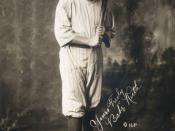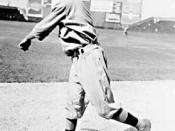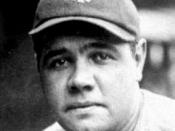Sports in the 1920s
Sports went through many changes in the time period known as the "Roaring Twenties." Some sports were just starting out; others were broadening their horizons, while others were simply becoming more popular. New heroes were emerging in sports, new teams, and even new leagues.
Although there were many greats in the 1920s, without a doubt, George "Babe" Ruth was the first and most famous out of all the heroes presented in this time. Ruth changed the whole game of baseball. Ruth was traded to the Yankees from the Red Sox on January 3, 1920 for $125,000. This was more than double the highest price paid for a player. The country had just come out of war, and the basic morale was low. Sports however, lightened the spirits of Americans. More and more people began attending sporting events. New, and more permanent, baseball stadiums had to be built to hold the volume of people that came to each game.
Also, with games now beginning to be broadcast on radio, people could stay in the comfort of their own home and listen to their favorite team. Ruth, among others, came at a time when the country was looking for, and needed heroes, and the new commercial radio stations of the 1920s (KDKA for example), gave people more access to them. Many people began to admire athletes such as the boxer Jack Dempsey, or golfers Bobby Jones and Walter Hagan, and other baseball players like Lou Gehrig and Ty Cobb. The country was in desperate need of distractions from the pain and suffering that had gone on during the war, and these men provided it.
Until 1926, there was no professional football, only college. There was but one football player, in most football spectator's eyes, Harold "Red" Grange. He was quoted as being "three or four men and a horse rolled into one." "He [was] Jack Dempsey, Babe Ruth, Al Jolson, Paavo Nurmi and Man o' War." Jolson was an accomplished Jazz singer of the time, Nurmi was the finest runner in the world in the 1920s, and Man o' War was the legendary racehorse of the 1920s. Red Grange was thought to be the greatest football player of all time, and when the public learned that he would be graduating college soon, thus not playing football anymore, they were very disappointed. Not wanting to upset his fans, Grange's agent, Charles G. "Cash & Carry" Pyle, formed the first professional football league around him. If there hadn't been a Red Grange, the NFL might not have been formed for quite some time.
Golf, at the time was mostly a European sport, not too many Americans had the time, or money to play golf. One man began to bring the game to America, Walter Hagan. In 1921 he became the first American-born professional golfer to win the PGA Championship, and a mere nine months later, he also became the first American-born professional golfer to win the British Open. Hagan was able to bring the appeal of golf to more Americans by defeating the British and bringing two Championships home. Bobby Jones also contributed to the popularity of golf. Although he was a great deal younger than Hagan, most people were attracted to his game because he was so young. In 1923 he won the US Open, his 1st major golf championship, as an amateur. Also, in 1926, Jones became the first golfer to win both the US and British Open in the same year. With Jones and Hagan sweeping the tournaments, golf was rapidly becoming one of the country's more popular games. Although golf, before their time, was reserved for the wealthy, many people began to have enough money to play because the economy was doing so well. In fact, most of the twenties were very profitable for many, but that all ended in October of 1929 with the crash. Nonetheless, Jones and Hagan paved the way for years of great American golfers to come.
Just about every sport in the 1920s expanded in one way or another by the end of the decade. As people's income was rising, therefore having more money to spend on luxuries, the attendance for sporting events also began to increase. Popularity of the games and ways for the media to tell what was going on were growing as well. In fact, the 1920s was proclaimed "The Golden Age of Sports."
Bibliography:
Sports Illustrated: 20th Century Sports: Images of Greatness, é 1999 Total/ SPORTS
ILLUSTRATED
ESPN: Sports Century, é 1999, ESPN, Inc.
http://www.kcstar.com/sports/history/aprsup.htm


